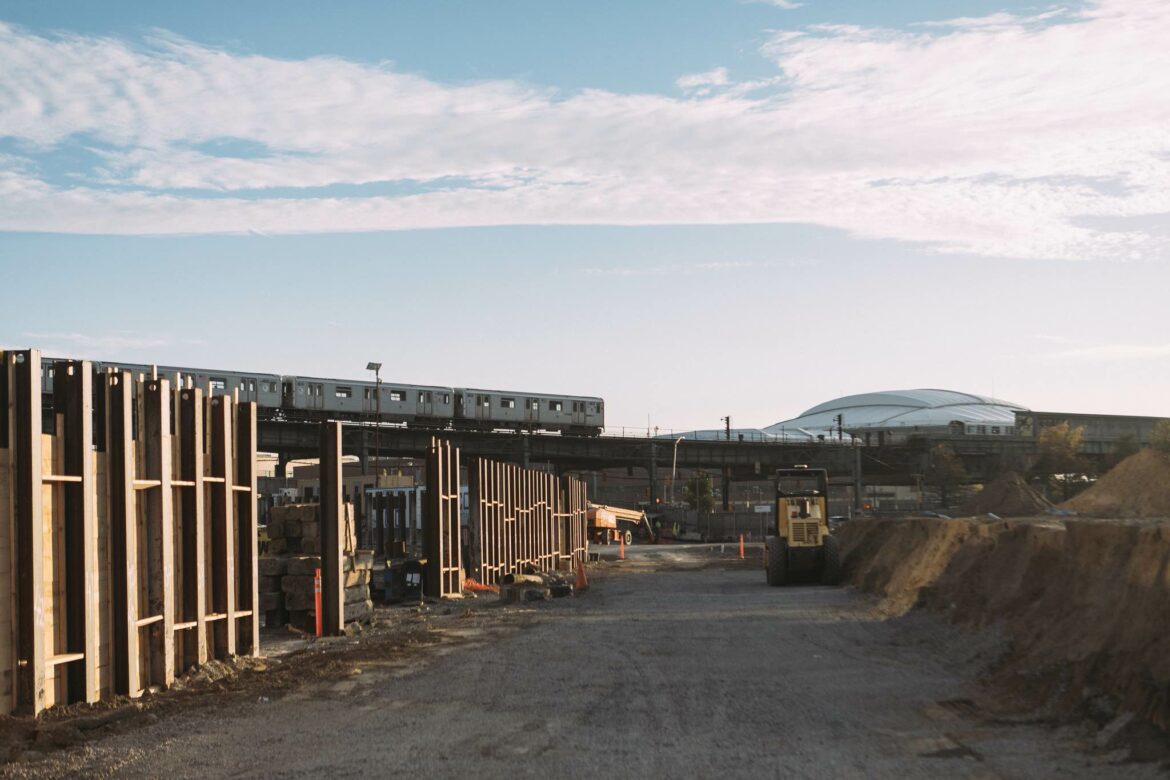
‘A Brand New Neighborhood’: City Council to Vote Soon on Willets Point Development
The proposal would build 1,400 income-restricted apartments—on top of 1,100 already in the works—on the Flushing waterfront just east of Citi Field. It also includes a privately financed stadium for the New York City Football Club.
Emil Cohen/NYC Council Media Unit
The site of the future soccer stadium at Willets Point, pictured here in November.
The City Council is expected to vote in the coming weeks on plans for the city’s first soccer stadium at Willets Point—along with hundreds of new apartments nearby—the latest chapter in decades of attempts at developing the Flushing waterfront site just east of Citi Field.
Phase I of the development, approved last year, green-lit the construction of 1,100 affordable housing units and a public school designed to accommodate up to 650 students.
Phase II, currently under consideration, seeks approval for another 1,400 affordable apartments, the addition of a 25,000-seat, privately financed stadium for the New York City Football Club (NYCFC), as well as a 250-room hotel.
With the city facing a historically low 1.4 percent housing vacancy rate, approval of the project would mark a significant housing win for the Adams administration’s “moonshot” goal of adding 500,000 new homes over the next decade. The City Planning Commission unanimously approved Phase II on March 6, and the City Council now has until April 26 to vote on the proposal under the city’s Uniform Land Use Review Procedure (ULURP) requirements.
“There hasn’t been this many number of affordable units coming online in decades, and it’s not just the stadium—this is a brand new neighborhood that’s coming to the borough of Queens,” said Queens District 21 Councilmember Francisco Moya, who represents Willets Point.
“I’m very proud of the work that I’ve been able to do to get this project to where it is today and hopefully in the upcoming weeks we’ll finalize that with a vote for approval at the Council,” he added.
Council approval is likely: Moya has been a major supporter of the plan, and under the longstanding tradition of “member deference,” the Council usually votes in line with the preferences of the district representative where the proposed land use change is located (though members have, on occasion, broken ranks).
Locally, the project has been met mainly with positive support, and easily passed 37-2 in a Queens Community Board 7 (CB7) endorsement vote in early December of last year.
But some community members have raised environmental concerns around building in the area, situated in a historic floodplain and partial wetlands.
Cody Herrmann, who sits on CB7 and is a founding member of the Guardians of Flushing Bay, was one of two board members who voted against the proposal. Speaking with City Limits in February, she expressed worry about the potential displacement of older low-income residents and the environmental challenges of building in the floodplain, despite the city’s reassurances that the development will be elevated.
She cited additional concerns based on a NASA study released in September of last year that indicated nearby areas in Queens, including the famed Arthur Arthur Ashe Stadium in Flushing Meadows-Corona Park, are sinking.
“These areas of land are sinking, and they’re sinking faster than anywhere else in the city,” said Herrmann. “So now we’re gonna put this new mega-development, tons and tons of housing, a huge soccer stadium into land that we know is sinking, into land that we know was a wetland that was filled in…it’s just not good long-term planning.”
Another criticism of the plan came after the New York Times reported last year on an Independent Budget Office analysis which projected the stadium would result in a loss of over half a billion dollars in tax revenue throughout the New York City Football Club’s (NYCFC) 49-year lease term, since the city isn’t collecting property taxes on the publicly-owned site.
The New York City Economic Development Corporation (EDC), which is actively involved in the project’s Uniform Land Use Review Process (ULURP), refuted these concerns, saying the IBO report was “grounded in an entirely implausible scenario” according to reporting by Gothamist earlier this month.
Speaking on the unique partnership the plan has with NYCFC, Moya looked to distinguish the Willets Point development from other athletic projects that have lagged on some of their commitments to surrounding communities.
“This stadium is 100 percent privately financed. Look at what happened at Atlantic Yards, Barclays. They still haven’t even begun to fulfill the commitments that they put forward,” said Moya, referring to affordable housing pledged as part of the Brooklyn stadium deal that have yet to be fully realized years later.
“Housing, we’ve already started on phase one,” Moya said of Willets Point. “You put housing first before anything else, and I think that just goes to the true dedication and the wanting to be part of the fabric of the community.”
According to city planning documents, income restricted units at the site are expected to target tenants earning anywhere from 30 percent of the Area Median Income—roughly $42,360 for a family of four—to 130 percent AMI, about $183,560 for a four person household.
The project is expected to spur 1,600 jobs and $6.1 billion in economic impact over the next 30 years, according to the EDC.
“For many years, this was joked to be the iron triangle, or the valley of the ashes,” Mayor Eric Adams at the groundbreaking for Phase I of in December. “We’re now going to see a vital community come about right here in the shadows of Shea Stadium.”
To reach the reporter behind this story, contact Chris@citylimits.org. To reach the editor, contact Jeanmarie@citylimits.org
Want to republish this story? Find City Limits’ reprint policy here.
The post ‘A Brand New Neighborhood’: City Council to Vote Soon on Willets Point Development appeared first on City Limits.


